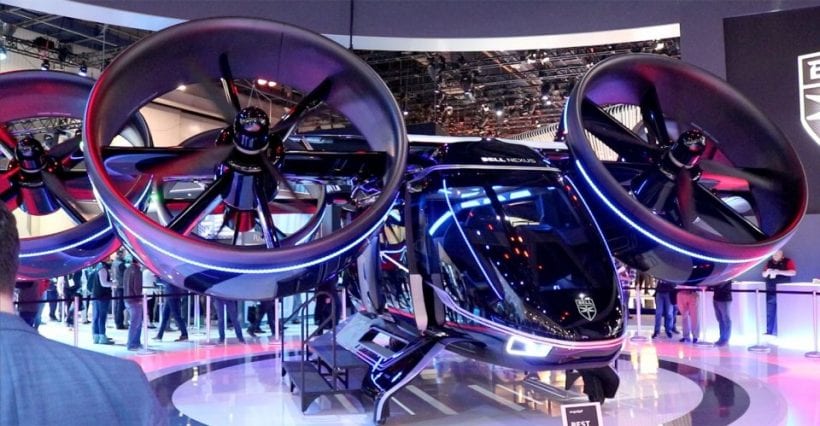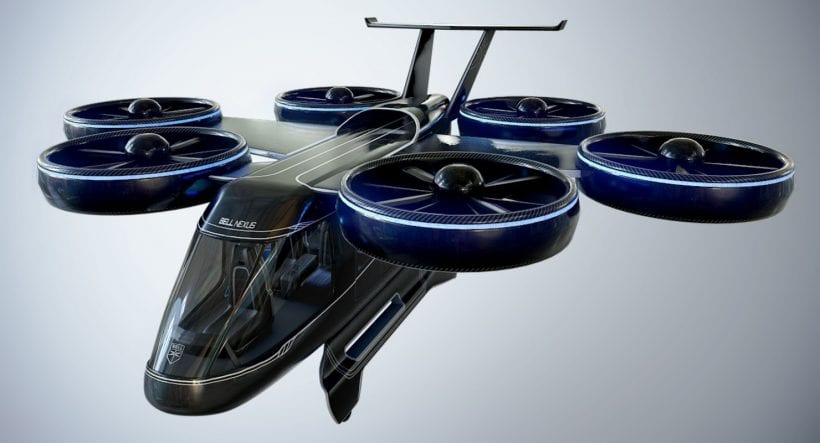While Elon Musk is working towards revolutionizing and easing traffic congestion, Bell Aerospace and Uber are taking it another level. At the beginning of this year, at the Consumer Electronics Show (CES) in Las Vegas, Bell revealed the latest replication of their Nexus VTOL aircraft. The vehicle is under development as the preferred platform for Uber’s Elevate air taxi program.
The Bell Nexus might look like an oversized drone at first glance, but the autonomous vehicle is so much more. It is a 6500-pound aircraft which features six, 8-foot articulated ducted fans. These fans enable the platform to lift off the ground vertically like a traditional helicopter before rotating 90 degrees. Thus, passengers will enjoy faster air travel, just like being on a plane. The landing is also very easy and convenient as the rotating fans get back into their original position and set down very gently.

The 40-foot by 40-foot landing pad is an exceptional feature of the Bell Nexus, meaning that cities won’t have to drastically change their existing infrastructure to accommodate them. The vehicle uses a hybrid electric power system which allows it to fly more efficiently and way more quietly than helicopters. The Nexus will have a pilot and will carry four passengers and will be able to travel 150 miles in just one hour. It will completely change people’s commute and it can turn a 45-minute drive into a 10-minute flight. Hence, it aims at saving people’s most valued resource, their time.
Bell Aerospace has produced several other VTOL aircraft over the years. They have been building helicopters since the Second World War and they’ve developed the V-22 Osprey. So, the company took many elements of the V-22 Osprey and applied them when creating Nexus.
However, Bell isn’t creating the new Nexus on their own, but they work with other companies in building the best aircraft, including Thales, Safran, Garmin, EPS, and Moog. Each of these companies is building individual subsystems.
For instance, the innovative technologies of Moog bring the design and integration of aircraft actuation systems for flight control to the Bell Nexus. Safran works the potential of hybrid solutions for future propulsion systems, while Thales develops the flight controls of the future. Garmin International, Inc. creates autonomous vehicle management computer systems for the Nexus, while EPS works towards incorporating its energy storage system that grips advanced active battery management technology.

The prototype which was shown at the 2019 International CES was non-operational. However, Bell Aerospace is planning to commence flight testing the aircraft by 2024 and start commercial operations shortly thereafter. It is expected that the residents of the Lone Star State will be among the first to have access before the program rolls out to the rest of the US as the company’s headquarters are there.
There is still no information on how much a trip with the Nexus will cost and we’ll probably be left wondering as the company first has to overcome some hurdles. Thus, they’re working on developing sensible regulations to enable these vehicles to operate safely among existing air traffic. When the Nexus is ready, both Bell Aerospace and Uber will have to convince the public that the air taxi service is reliable, convenient, safe, and cost-effective. Until then, we can enjoy looking at the breathtaking pictures of the Bell Nexus and its interior.

